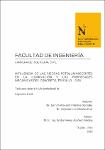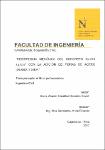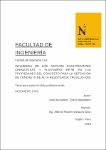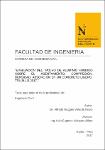Mostrar el registro sencillo del ítem
Influencia de las piedras fotoluminiscentes en la iluminación y las propiedades mecánicas del concreto, Trujillo – 2018
| dc.contributor.advisor | Azañedo Medina, Wiston Henry | |
| dc.contributor.author | Medina Gonzalez, Jazmith Alexandra | |
| dc.contributor.author | Moreno Cruz, Jheysson Luis | |
| dc.date.accessioned | 2019-02-05T18:02:43Z | |
| dc.date.available | 2019-02-05T18:02:43Z | |
| dc.date.issued | 2019-01-21 | |
| dc.identifier.citation | Medina, J. A., & Moreno, J. L. (2018). Influencia de las piedras fotoluminiscentes en la iluminación y las propiedades mecánicas del concreto, Trujillo – 2018 [Tesis de licenciatura, Universidad Privada del Norte]. Repositorio de la Universidad Privada del Norte. Recuperado de https://hdl.handle.net/11537/14823 | es_PE |
| dc.identifier.other | 624.1834 MEDI 2018 | es_PE |
| dc.identifier.uri | https://hdl.handle.net/11537/14823 | |
| dc.description.abstract | El propósito de la presente investigación es determinar la iluminación de las piedras fotoluminiscentes incrustadas en el concreto convencional y evaluar la influencia en las propiedades mecánicas del mismo. Para los ensayos se elaboraron probetas patrón y probetas con una capa superficial de piedras fotoluminiscentes. Todos los ensayos se realizaron tomando en cuenta las recomendaciones de las Normas Técnicas Peruanas (NTP), Ministerio de Transportes y Comunicaciones (MTC), el Instituto Americano del Concreto (ACI) y la Norma Española (UNE). Los resultados experimentales demuestran que la iluminación de las piedras fotoluminiscentes no se ve afectada por el tiempo que estas se encuentran expuestas a la luz de las lámparas. En el caso de la resistencia a la compresión, las probetas patrón poseen una resistencia de 330.31±6.96 kgf/cm2, mientras que la resistencia con incrustaciones de piedras fotoluminiscentes alcanzó una resistencia de 331.85±4.77 kgf/cm2. Respecto a la resistencia a la flexión los resultados arrojaron un valor de 45.78±2.06 kgf/cm2 para las probetas patrón y 45.85±1.53 kgf/cm2 para las probetas con incrustaciones de piedras fotoluminiscentes, lo cual demuestra que no existe una disminución en las propiedades mecánicas del concreto debido a la presencia de las piedras fotoluminiscente. Por otro lado, la iluminación medida a las alturas de 15 cm y 40 cm es de 5.08±0.19 lux y 4.32±0.19 lux respectivamente. Para los ensayos de iluminación se han seguido las recomendaciones de la Norma Española. Por último, se realizaron siete ensayos adicionales de iluminación, un ensayo de luz ultravioleta y un ensayo dirigido al tiempo de descarga de las piedras fotoluminiscente. Los resultados demuestran que el concreto fotoluminiscente fabricado en este trabajo cumple con la iluminación mínima a los 10 minutos según la UNE 23035 y su tiempo de descarga es mayor a 8 horas. | es_PE |
| dc.description.abstract | The purpose of the present investigation is to determine the illumination of the photoluminescent stones in conventional concrete and to evaluate the influence on the mechanical properties of the same. For the tests, standard specimens and specimens were made with a surface layer of photoluminescent stones. All the tests are based on the recommendations of the Peruvian Technical Standards (NTP), Ministry of Transport and Communications (MTC), the American Concrete Institute (ACI) and the Spanish Standard (UNE). The experimental results show that the illumination of photoluminescent stones is not affected by the time they are exposed to the light of the lamps. In the case of the compressive strength, the standard specimens have a resistance of 330.31 ± 6.96 kgf/cm2, while the resistance with incrustations of photoluminescent stones reached a resistance of 331.85 ± 4.77 kgf/cm2. Regarding the resistance to bending, the results showed a value of 45.78 ± 2.06 kgf/cm2 for the standard specimens and 45.85 ± 1.53 kgf/cm2 for specimens with photoluminescent stone incrustations, which shows that there is no decrease in the mechanical properties of concrete due to the presence of photoluminescent stones. On the other hand, the illumination measured at heights of 15 cm and 40 cm is 5.08 ± 0.19 lux and 4.32 ± 0.19 lux respectively. For lighting trials, the recommendations of the Spanish Standard have been followed. Finally, seven additional lighting tests, a UV radiation test and an essay directed at the discharge time of the photoluminescent stones were carried out. The results show that the photoluminescent concrete manufactured in this work meets the minimum lighting at 10 minutes according to UNE 23035 and its discharge time is greater than 8 hours. | es_PE |
| dc.description.uri | Tesis | es_PE |
| dc.language.iso | spa | es_PE |
| dc.publisher | Universidad Privada del Norte | es_PE |
| dc.rights | info:eu-repo/semantics/openAccess | es_PE |
| dc.source | Universidad Privada del Norte | es_PE |
| dc.source | Repositorio Institucional - UPN | es_PE |
| dc.subject | Estructuras | es_PE |
| dc.subject | Iluminación | es_PE |
| dc.subject | Concreto | es_PE |
| dc.title | Influencia de las piedras fotoluminiscentes en la iluminación y las propiedades mecánicas del concreto, Trujillo – 2018 | es_PE |
| dc.type | info:eu-repo/semantics/bachelorThesis | es_PE |
| thesis.degree.grantor | Universidad Privada del Norte. Facultad de Ingeniería | es_PE |
| thesis.degree.level | Título Profesional | es_PE |
| thesis.degree.discipline | Ingeniería Civil | es_PE |
| thesis.degree.name | Ingeniero Civil | es_PE |
| dc.publisher.country | PE | es_PE |
| dc.subject.ocde | https://purl.org/pe-repo/ocde/ford#2.01.01 | es_PE |
| thesis.degree.program | Pregrado | es_PE |
| dc.description.sede | Trujillo San Isidro | es_PE |
| renati.advisor.dni | 41526075 | |
| renati.advisor.orcid | https://orcid.org/0000-0003-1737-3500 | es_PE |
| renati.author.dni | 70284037 | |
| renati.author.dni | 74217795 | |
| renati.discipline | 732016 | es_PE |
| renati.juror | Rivera Muñoz, Melving Luis | |
| renati.juror | Diestra Cruz, Heberth Alexander | |
| renati.juror | Vásquez Díaz, Alberto Rubén | |
| renati.level | https://purl.org/pe-repo/renati/level#tituloProfesional | es_PE |
| renati.type | http://purl.org/pe-repo/renati/type#tesis | es_PE |
Ficheros en el ítem
Este ítem aparece en la(s) siguiente(s) colección(ones)
-
Tesis [1439]







